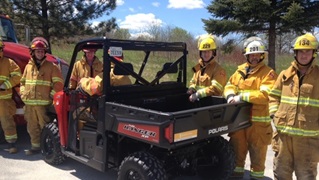A green sanctuary in an urban setting
Hamilton Conservation Authority helps preserve ecological corridor in Southern Ontario
How does a green corridor get built in an urban environment?
Brick by brick, you might say.
As part of environmental restoration work within the Cootes to Escarpment EcoPark System, “one of our major projects is the restoration of a former greenhouse property in the Desjardins Canal Parklands,” notes Grace Correia, executive director of the Hamilton Conservation Foundation.
“There’s an old chimney on site that may cause some people to wonder,” she adds. “It’s home to the chimney swift, which is a species at risk in Ontario. So we made sure to leave it standing.”
The Cootes to Escarpment EcoPark System, which includes the Desjardins Canal Parklands, runs through some of Canada’s most densely populated territory, the Hamilton-Burlington region of Southern Ontario.
Among Canada’s largest urban natural parks, it’s also one of the most biologically rich areas in the country, with natural lands, wetlands and open water. All told, the Cootes to Escarpment EcoPark System includes about 4,700 acres of natural lands at the western end of Lake Ontario, and is protected through a partnership of 10 local government and non-profit organizations.
This ecological corridor includes a UNESCO World Biosphere Reserve, in the Niagara Escarpment, and is also home to more than 50 Ontario species at risk—including the Blanding’s turtle, the black tern, the Jefferson salamander, the hooded warbler, the woodland vole, the American white pelican, the monarch butterfly, the southern flying squirrel, and the chimney swift.
“It’s a vital connection from the Escarpment to the water,” says Correia, “so that animals can move about freely.”
In the Desjardins Canal Parklands area, the Hamilton Conservation Authority, with fundraising help from the Hamilton Conservation Foundation, has completed a significant restoration project. That work, carried out with the help of ecologists and school and community volunteer groups, includes:
- Installing new trails, signage, and seating areas for visitor enjoyment;
- Planting native species of an upland prairie habitat;
- Re-establishing marsh vegetation along the 175-year-old canal; and
- Launching a series of “floating islands” with vegetation in the canal to help purify the water.
Enbridge is committed to enhancing quality of life in the communities near our operations and projects, including the Line 10 Westover Segment Replacement Project in the Hamilton area.
We invest in community initiatives that promote environmental stewardship, conservation, and habitat remediation, and that includes a recent $15,000 donation toward the HCA’s restoration and outdoor education work in the region.
While the public is already welcome to this restored green belt, the Desjardins Canal Parklands area will be officially opened in an Aug. 20 ceremony—and given a new moniker, through an HCA naming contest.
“This is a green oasis in the middle of a big city—an opportunity for recreation, a walk in the woods,” says Correia. “At the same time, it’s a sanctuary for so many animal and plant species.”










